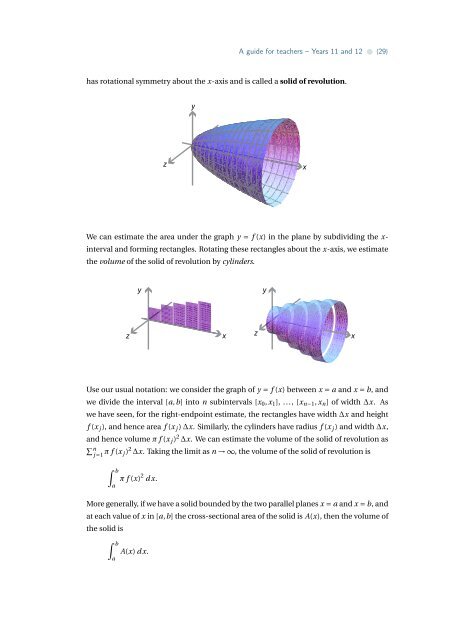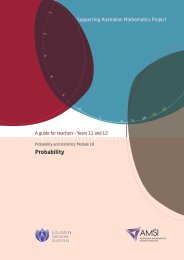Integration - the Australian Mathematical Sciences Institute
Integration - the Australian Mathematical Sciences Institute
Integration - the Australian Mathematical Sciences Institute
Create successful ePaper yourself
Turn your PDF publications into a flip-book with our unique Google optimized e-Paper software.
A guide for teachers – Years 11 and 12 • {29}has rotational symmetry about <strong>the</strong> x-axis and is called a solid of revolution.yzxWe can estimate <strong>the</strong> area under <strong>the</strong> graph y = f (x) in <strong>the</strong> plane by subdividing <strong>the</strong> x-interval and forming rectangles. Rotating <strong>the</strong>se rectangles about <strong>the</strong> x-axis, we estimate<strong>the</strong> volume of <strong>the</strong> solid of revolution by cylinders.yyyzxzxUse our usual notation: we consider <strong>the</strong> graph of y = f (x) between x = a and x = b, andwe divide <strong>the</strong> interval [a,b] into n subintervals [x 0 , x 1 ], ..., [x n−1 , x n ] of width ∆x. Aswe have seen, for <strong>the</strong> right-endpoint estimate, <strong>the</strong> rectangles have width ∆x and heightf (x j ), and hence area f (x j ) ∆x. Similarly, <strong>the</strong> cylinders have radius f (x j ) and width ∆x,and hence volume π f (x j ) 2 ∆x. We can estimate <strong>the</strong> volume of <strong>the</strong> solid of revolution as∑ nj =1 π f (x j ) 2 ∆x. Taking <strong>the</strong> limit as n → ∞, <strong>the</strong> volume of <strong>the</strong> solid of revolution is∫ baπ f (x) 2 d x.More generally, if we have a solid bounded by <strong>the</strong> two parallel planes x = a and x = b, andat each value of x in [a,b] <strong>the</strong> cross-sectional area of <strong>the</strong> solid is A(x), <strong>the</strong>n <strong>the</strong> volume of<strong>the</strong> solid is∫ baA(x) d x.
















